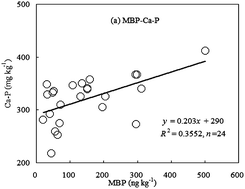Phosphine (PH3) is a natural gaseous carrier of phosphorus (P) in its geochemical cycles, and it might be important to the P balance of natural ecosystems. Paddy fields are thought to be one of the main sources responsible for the production and emission of PH3 in to the environment. The relationships between matrix-bound PH3 (MBP) and different P fractions, as well as selected metals were investigated to explore the possible production of MBP and its link to P cycle in the paddy soils. MBP range from 20.8 −1 to 502 ng kg−1 with an average of 145 ng kg−1. Concentrations at the milk stage are significantly higher than at the jointing stage. The total P range from 333 mg kg−1 to 592 mg kg−1. Average P fractions decrease in the order: Ca–P (69.9%) > Organic P (16.5%) > occluded P (6.50%) > Fe–P (5.93%) > dissolved P (0.80%) > exchangeable P (0.32%) > Al–P (0.02%). Different levels of nitrogen fertilizer have little effect on the contents of MBP, P fractions and metals. A significant positive correlation between MBP and Ca–P (p = 0.002), as well as between MBP and Ca (p = 0.008) could be observed, suggesting that Ca–P mainly affects the production of MBP in the paddy soils. It is suggested that soil MBP is strongly linked to Ca–P fertilizer use because soil spiked with P-fertilizer produced an additional 758 ± 142 ng of MBP per kg of soil, compared to only 81.7 ± 12.3 ng of MBP per kg of unspiked soil. No correlations are found between MBP and other P fractions, or between MBP and Al, Fe and Mn.

You have access to this article
 Please wait while we load your content...
Something went wrong. Try again?
Please wait while we load your content...
Something went wrong. Try again?


 Please wait while we load your content...
Please wait while we load your content...